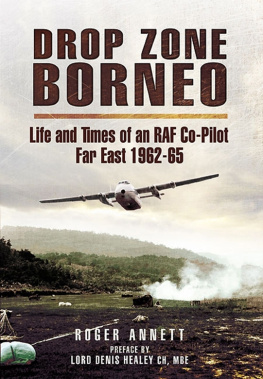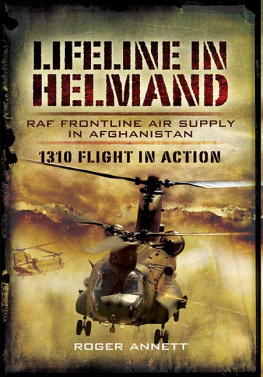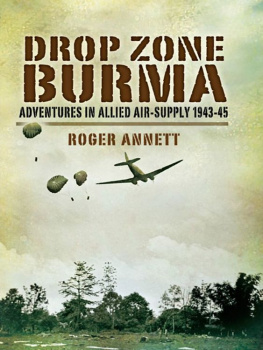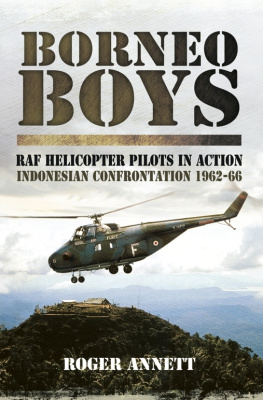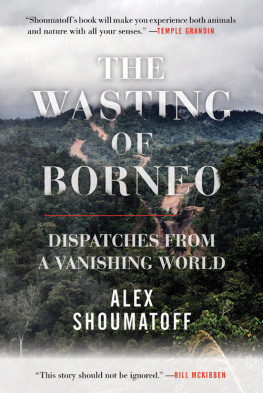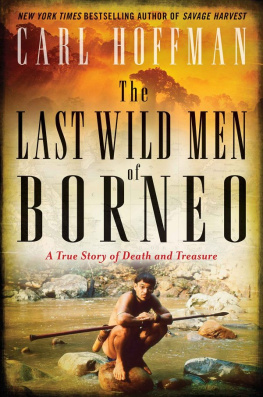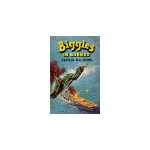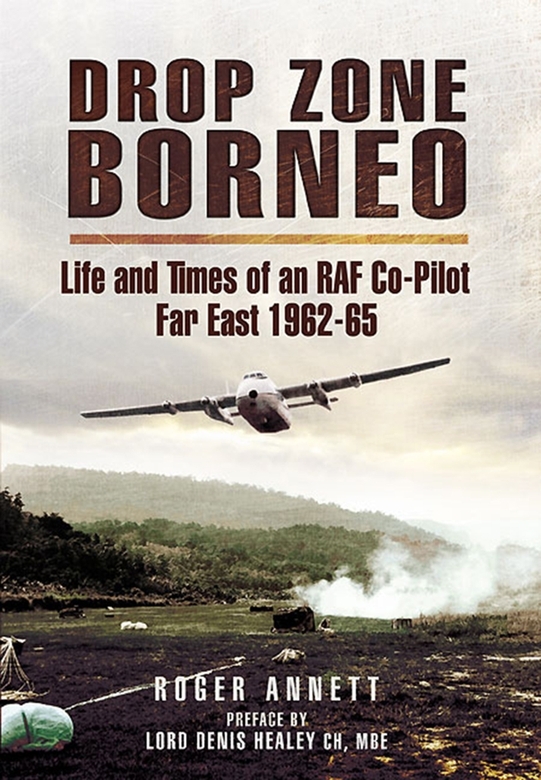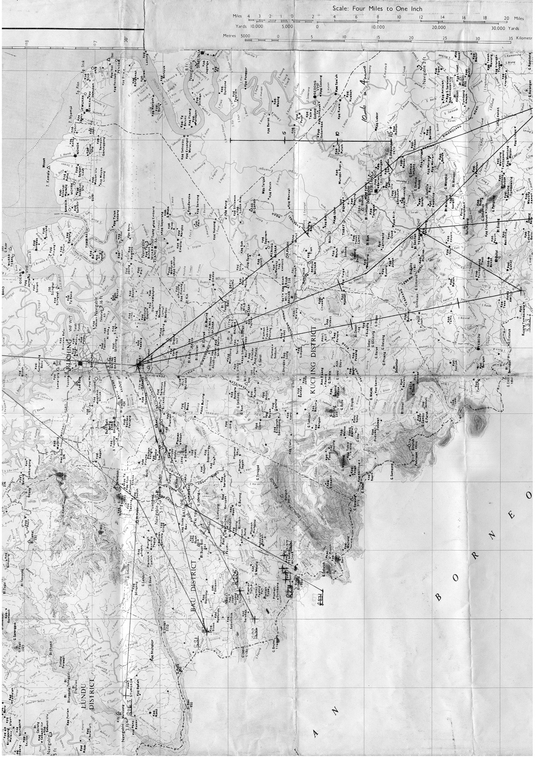Acknowledgements
M y thanks go to the many people whose contributions, insights and unfailing encouragement were generously offered during the preparation of this story.
Tom Sneddon painstakingly read the manuscript, correcting factual howlers and allowing free access to his own notes and records. These included selections from his letters home from the Far East, discovered in a box in his late mothers attic. Barry and Dorothy Priests loft yielded equally priceless souvenirs and Mike Keane, a Changi Kiwi, produced the splendid Sarawak navigation chart. Both Dominic Parkinson and Dickie Miller unearthed valuable video footage (originally cine film) of the Confrontation years.
I am greatly indebted to Tony Stephens, recently Deputy Head at the Air Historical Branch. Here, Seb Cox, Flight Lieutenant Mary Hudson and Clive Richards gave me every assistance among the RAF Report Forms 540 and bundles of photographs. Tony also referred me to Henry Probert, whose advice was invaluable.
John Leary was a guide and mentor, not least among the RAF aviation accounts found in back-numbers of Air Clues at the RAF Museum at Hendon. He reintroduced me to Tony Talbot-Williams, to whom I am grateful for his helpful cooperation.
Geoff Walker, John Horsfall and Taff Howell put me in touch with old 215 Squadron friends from Borneo days: Pat Gorman, Jack Davies, John Hare, Tommy Norcross, Graham Wade, Mike Robson, Rod Twitchett and Jack Ord all gladly shared their recollections, as did Val McCarthy, Terry Keats and Hugh Rolfe from other squadrons.
I am grateful to Roger Draper for his part in initiating this project and to Celia Kent for her professional counsel and an introduction to Lord Healey, who kindly gave his ministerial viewpoint.
My foremost thanks go to my wife, Jenny, for her inestimable contribution to the writing and editing of this book. Without her, the tale would not have been told.
Roger Annett
Spring 2006
Appendix
215 Squadron Personnel at Changi
Squadron Commander : Wg Cdr A. Talbot-Williams MA
Engineering Officer : Flt Lt David Birch
Squadron Adjutant : WO Dick Shepherd
| Captain: | Co-pilot: | Navigator: |
|---|
| Flight Commanders: |
| Sqn Ldr P. G. Hill-Turner | Flt Lt I. G. Mackie | Flt Lt T. R. Norcross |
| Sqn Ldr J. M. Leary (AFC Jan 65) | Fg Off R. M. Annett | Flt Lt R. M. Wilkins (Nav Ldr) |
| Flt Lt G. Garforth (transferred to Wing) | Flt Lt M. R. Smith | Flt Lt E. W. Harrison DFC |
| Flt Lt J. S. Horrocks | Flt Lt G. D. Taylor (to capt) | Flt Lt J. M. Hare (to Sqn Ldr & Flt Cdr) |
| Flt Lt R. T. D. Scott | Fg Off D. Lovett | Flt Lt P. H. Verdon |
| Flt Lt D. Fairbairn | Flt Lt K. McAllen (to capt) | Fg Off G. R. Walker |
| Flt Lt D. G. Allen | Fg Off P. J. Gorman | Fg Off A. C. Ewer |
| Flt Lt A. McF. Adams | Fg Off W. M. N. Cross | Fg Off D. J. Parkinson |
| Flt Lt B. A. Stevens | Fg Off J. B. Davies | Flt Lt D. S. Gates |
| Flt Lt J. B. Black | Fg Off B. P. Nicolle | Fg Off T. J. Sneddon |
| Flt Lt R. A. Miller (Queens Commendation 65) | Fg Off R. R. Lewis | Fg Off J. A. Smith |
| Flt Lt H. G. Mitchell | Fg Off P. A. Fish | Fg Off R. M. Cooper |
| Flt Lt J. Horsfall | Fg Off E. Deacon | Flt Lt H. G. Westell |
| Flt Lt R. Tunnicliffe | Flt Lt A. C. Baker | Flt Lt D. Clements |
| Fg Off D. G. Thompson | Fg Off D. Marshall | Fg Off K. H. Graham |
| Flight Engineers: | Air Quartermasters: |
|---|
| Flt Lt Dennis Hollingsworth (Engineer Leader) | Master AQM Paddy Kane |
| Master Eng (Mister) Howarth (25 years service tankard 64) | Flt Sgt Paddy OLoughlin |
| Master Eng Chalky White | Flt Sgt Colin Bateman |
| Master Eng Bruce Meteer (25 years service tankard 64) | Flt Sgt J. R. Pete Jillings |
| Master Eng Jock Stewart | Flt Sgt Ken Watson |
| Master Eng Smudge Smith | Flt Sgt Jack Winyard |
| Flt Sgt Jim Coates | Sgt Geoff Longmuir |
| Flt Sgt Tug Wilson | Sgt Bob Hodges |
| Sgt Eric Goodall | Sgt Taff Howell |
| Sgt R. Eddy Godwin | Sgt John Donnelly |
| Sgt Pete Webb | Sgt Rex Giles |
| Sgt Ken Parkinson | Sgt Pat Halliday |
| Sgt Don Farrow | Sgt Brian Bascoby |
| Sgt John Meacher | Sgt Jimmy Harris |
| Sgt Duncan Macintosh |
Bibliography
Air Clues magazine (various), Royal Air Force Directorate of Flight Safety, HMSO.
Dickens, Peter, SAS: The Jungle Frontier 22 SAS Regiment in the Borneo Campaign 1963 1966, Arms & Armour Press (1983).
Geraghty, Tony, Who Dares Wins: The Story of the SAS 1950 to the Gulf War, Warner Books.
Guide to Singapore and Spotlight on Malaysia, 16th edn, Papineau Advertising, Singapore (December 1962).
Harclerode, Peter, PARA: Fifty Years of the Parachute Regiment, Arms & Armour Press (1992).
Harrisson, Tom, World Within: A Borneo Story, Cresset Press (1959).
Lee, Air Chief Marshal Sir David, Eastward: A History of the Royal Air Force in the Far East 1945 1972, HMSO (1984).
Nelles Guide to Malaysia (1995).
Probert, Squadron Leader H. A., The History of Changi, RAF Education Flight, Changi (1965).
RAF Forms 540, RAF Air Historical Branch, Bentley Priory.
Van der Post, Laurens and Murray, John, The Admirals Baby, William Morrow & Co. (1997).
41 Squadron RNZAF Kuching Ops. Chart. (Courtesy Mike Keane)
CHAPTER ONE
Mission to the Mountains
O n the island the early morning air is cool and still, and the blue horizon is streaked with gold. The waters of the South China Sea lap gently onto the coral beach. Insects, birds and frogs call across the treetops and among the grasses. Against the lightening sky to the north-east rises the black shape of Kinabalu, a humpback mountain sacred to the tribes living in its shadow. The scent of frangipani is in the air challenged by the smell of streaky bacon frying in the mess tent.
For this is a remote airbase of the British Far East Air Force on Labuan some 50 square-miles of scrub, swamp and secondary jungle, lying 20 miles off the north-west coast of Borneo.
The equatorial sun rises fast, picking out the threatening shapes of warplanes fighters, maritime patrol aircraft, helicopters and freighters. Today, one of the transports is tasked with carrying some 16,000 lb of military supplies 100 nautical miles into Borneos unmapped mountain and jungle interior. There, its crew has to find three dropping zones each not much bigger than a cricket-pitch, and deliver this load by parachute to the British troops waiting on the ground.
The freighter is an Armstrong Whitworth Argosy, a twin-boom, high wing tactical transport, powered by four Rolls-Royce Dart MK 101 turboprops. The RAF has eight of these aircraft stationed with 215 Squadron at Changi in Singapore, 800 miles to the west. Aircraft XR107 has made the four-hour flight out to Labuan, ready to begin a ten-day detachment the first for the squadron in the Borneo Campaign.

